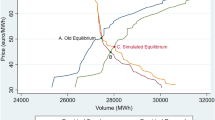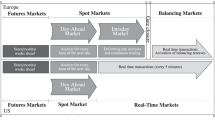Abstract
In this chapter, we provide an overview of the electricity market structure and discuss its characteristics. We also survey the regulation policies on electricity prices and the existing price forecasting techniques in a market-driven electricity industry. The complex nature of electricity markets makes it difficult to design optimal policies for the policy makers. It also makes it challenging for market participants to conduct price forecasting. Additionally, the dynamic nature of the electricity markets creates strong demand for researchers to come up with a more accurate prediction.
Similar content being viewed by others
Notes
- 1.
Electricity market restructuring started in Australia, Chile, and the U.K. in the 1980s, followed by a larger-scale liberalization in the European Union and the U.S. in the 1990s.
- 2.
Additional costs may arise if transmission congestion occurs. In such cases, the locational marginal price (LMP) or the zonal market clearing price (ZMCP) mechanisms may be implemented. LMP is defined as specific “network buses” while ZMCP is defined by different regions (zones) which can include many “network buses.” Both the LMP and the ZMCP incorporate the additional transmission congestion costs to determine prices.
- 3.
Despite concerns over the growing retail tariff deficit due to suboptimal rates, the Spanish government imposed price controls that restricted the annual rate increases to be below 1.4%. Since 2000, the retail tariff revenues have been too small to recover the costs of power network operation creating large government deficits which are estimated to be 26.9 Billion euros [16].
- 4.
Several states in the U.S. implemented retail rate controls to reduce electricity prices by 3–20% followed by a rate freeze during the electricity market restructuring. These price controls were motivated by concerns of the market power in the wholesale and retail sectors during the transition period [28]. In the electricity crisis in California, for example, an unexpected rise in natural gas prices caused the equilibrium electricity wholesale prices to exceed the mandated retail prices by up to 500% [12]. Retail price controls, therefore, are cited as one of the factors that led to the 2000–2001 California electricity crisis [15].
- 5.
A covariance-stationary process is referred to as a weakly stationary process. A strong stationary process can have a finite mean and/or variance.
References
Alberta Government: Price cap to protect consumers from volatile electricity prices. https://www.alberta.ca/ (2016)
Amjady, N., Keynia, F.: Electricity price forecasting with a new feature selection algorithm. J. Energy Mark. 1(4), 47–63 (2008)
Amjady, N., Keynia, F.: Day-ahead price forecasting of electricity markets by a new feature selection algorithm and cascaded neural network technique. Energy Convers. Manag. 50(12), 2976–2982 (2009)
Amjady, N., Keynia, F.: Day-ahead price forecasting of electricity markets by mutual information technique and cascaded neuro-evolutionary algorithm. IEEE Trans. Power Syst. 24(1), 306–318 (2009)
Amjady, N., Keynia, F.: Electricity market price spike analysis by a hybrid data model and feature selection technique. Electr. Power Syst. Res. 80(3), 318–327 (2010)
Bello, A., Bunn, D., Reneses, J., Muñoz, A.: Parametric density recalibration of a fundamental market model to forecast electricity prices. Energies 9, 959 (2016)
Bello, A., Reneses, J., Muñoz, A.: Medium-term probabilistic forecasting of extremely low prices in electricity markets: application to the spanish case. Energies 9, 193 (2016)
Bollerslev, T.: Generalized autoregressive conditional heteroscedasticity. J. Econ. 31, 307–327 (1986)
Borenstein, S.: Effective and equitable adoption of opt-in residential dynamic electricity pricing. Rev. Ind. Organ. 42(2), 127–160 (2013)
Box, G., Jenkins, G.: Time Series, Forecasting, and Control. Holden Day, San Francisco, CA (1976)
Box, G., Tao, G.: Intervention analysis with applications to economic and environmental problems. J. Am. Stat. Assoc. 70(349), 70–79 (1975)
Brennan, T., Palmer, K., Martinez, S.: Implementing electricity restructuring: policies potholes, and prospects. Discussion Paper 01–62, Resources For the Future (2001)
Brown, D., Eckert, A., Eckert, H.: Electricity markets in transition: market distortions associated with retail price controls. Electr. J. 30(5), 32–37 (2017)
Catalão, J., Pousinho, H., Mendes, V.: Hybrid wavelet-PSO-ANFIS approach for short-term electricity prices forecasting. IEEE Trans. Power Syst. 26(1), 137–144 (2011)
CBO: Causes and lessons of the California electricity crisis. A Congressional Budget Office Report (2001)
CNMC: Spanish energy regulator’s national report to the european commission 2015. Comision Nacional De Los Mercados Y La Competencia (2015)
Engle, R.: Autoregressive conditional heteroscedasticity with estimates of the variance of united kingdom inflation. Econometrica 50, 987–1007 (1982)
Faruqui, A., Hledik, R., Palmer, J.: Time-Varying and Dynamic Rate Design. Global Power Best Practice Series. The Brattle Group, Boston, MA (2012)
Federico, G., Vives, X.: Competition and regulation in the Spanish gas and electricity markets. Reports of the Public-Private Sector Research Center. IESE Business School (2008)
Gianfreda, A., Grossi, L.: Forecasting italian electricity zonal prices with exogenous variables. Energy Econ. 34(6), 2228–2239 (2012)
González, C., Mira-McWilliams, J., Juárez, I.: Important variable assessment and electricity price forecasting based on regression tree models: classification and regression trees, bagging and random forests. IET Gener. Transm. Distrib. 9(11), 1120–1128 (2015)
Hong, Y., Wu, C.: Day-ahead electricity price forecasting using a hybrid principal component analysis network. Energies 5(11), 4711–4725 (2012)
Illinois General Assembly: Senate bill 2814. Public Act 099–0906 (2016)
Ito, K.: Do consumers respond to marginal or average price? Evidence from nonlinear electricity pricing. Am. Econ. Rev. 104(2), 537–563 (2014)
Jiang, P., Liu, F., Song, Y.: A hybrid multi-step model for forecasting day-ahead electricity price based on optimization, fuzzy logic and model selection. Energies 9, 618 (2016)
Karakatsani, N., Bunn, D.: Forecasting electricity prices: the impact of fundamentals and time-varying coefficients. Int. J. Forecast. 24(4), 764–785 (2008)
Keles, D., Scelle, J., Paraschiv, F., Fichtner, W.: Extended forecast methods for day-ahead electricity spot prices applying artificial neural networks. Appl. Energy 162, 218–230 (2016)
Kwoka, J.: Restructuring the U.S. electric power sector: a review of recent studies. Rev. Ind. Organ. 32(3), 165–196 (2008)
Lessem, N., Faruqui, A., Sergici, S., Mountain, D.: The impact of time-of-use rates in Ontario. Public Utilities Fortnightly (2017)
Li, C., Sun, W.: The study on electricity price forecasting method based on time series ARMAX model and chaotic particle swarm optimization. Int. J. Adv. Comput. Technol. 4(15), 198–205 (2012)
Ludwig, N., Feuerriegel, S., Neumann, D.: Putting Big Data analytics to work: feature selection for forecasting electricity prices using the LASSO and random forests. J. Decis. Syst. 24(1), 19–36 (2015)
Misiorek, A.: Short-term forecasting of electricity prices: do we need a different model for each hour? Medium Econ. Toepassingen 16(2), 8–13 (2008)
Morey, M., Kirsch, L.: Retail choice in electricity: what have we learned in 20 years? Christensen Associated Energy Consulting (2016)
Niu, D., Liu, D., Wu, D.: A soft computing system for day-ahead electricity price forecasting. Appl. Soft Comput. 10(3), 868–875 (2010)
Osório, G., Gonçalves, J.N.D.L., Lujano-Rojas, J.M., Catalão, J.P.S.: Enhanced forecasting approach for electricity market prices and wind power data series in the short-term. Energies 9, 693 (2016)
Ros, A.: An econometric assessment of electricity demand in the United States using panel data and the impact of retail competition on prices. NERA Economic Consulting (2015)
Shafie-khah, M., Moghaddam, M.P., Sheikh-El-Eslami, M.K.: Price forecasting of day-ahead electricity markets using a hybrid forecast method. Energy Convers. Manag. 52(5), 2165–2169 (2011)
Simshauser, P., Laochumnanvanit, K.: The political economy of regulating retail electricity price caps in a rising cot environment. Electr. J. 25(9), 48–66 (2012)
Tong, H.: Threshold Models in Nonlinear Time Series Analysis. Springer, New York (1983)
Uniejewski, B., Nowotarski, J., Weron, R.: Automated variable selection and shrinkage for day-ahead electricity price forecasting. Energies 9, 621 (2016)
Voronin, S., Partanen, J.: Price forecasting in the day-ahead energy market by an iterative method with separate normal price and price spike frameworks. Energies 6, 5897–5920 (2013)
Wu, L., Shahidehpour, M.: A hybrid model for day-ahead price forecasting. IEEE Trans. Power Syst. 25(3), 1519–1530 (2010)
Ziel, F.: Forecasting electricity spot prices using lasso: on capturing the autoregressive intraday structure. IEEE Trans. Power Syst. 31(6), 4977–4987 (2016)
Ziel, F., Steinert, R., Husmann, S.: Efficient modeling and forecasting of electricity spot prices. Energy Econ. 47, 89–111 (2015)
Acknowledgements
Work of P.M. Pardalos is partially supported by the Paul and Heidi Brown Preeminent Professorship at ISE, University of of Florida.
Author information
Authors and Affiliations
Corresponding author
Editor information
Editors and Affiliations
Rights and permissions
Copyright information
© 2017 Springer International Publishing AG
About this chapter
Cite this chapter
Pardalos, P.M., Singh, A., Wang, W. (2017). Electricity Market Structure and Pricing Analyses. In: Butenko, S., Pardalos, P., Shylo, V. (eds) Optimization Methods and Applications . Springer Optimization and Its Applications, vol 130. Springer, Cham. https://doi.org/10.1007/978-3-319-68640-0_18
Download citation
DOI: https://doi.org/10.1007/978-3-319-68640-0_18
Published:
Publisher Name: Springer, Cham
Print ISBN: 978-3-319-68639-4
Online ISBN: 978-3-319-68640-0
eBook Packages: Mathematics and StatisticsMathematics and Statistics (R0)




